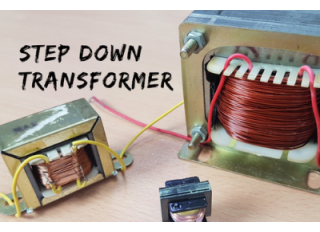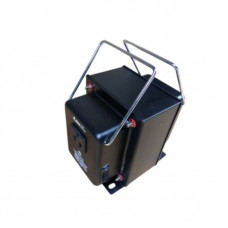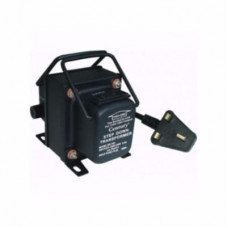Blog
Why you need a step-down transformer ?

Before we
discuss about a step-down transformer, we will discuss briefly on a
transformer.
What is a
transformer? Transformers serve as the cornerstone of our modern society by
providing electricity at large levels without straining the power grid. They
serve as a bridge between the electrical power system and the distribution
system.
They are
used in power generation, transmission, distribution, and many other fields.
Transformers help us harness energy from sources like wind, water, and other
sources of renewable energy.
They can be
found in hundreds of places across the world, from homes to hospitals to
industries and more. They are also the key component in many electrical
machines such as wind turbines, solar systems, electric cars, and electric
boats.
How does a transformer work?
Transformers
are used all around the world because they have properties that make them
suitable for use in almost any situation.
They can
convert electrical energy into mechanical energy and vice versa without burning
out. A transformer works by changing the voltage of an electrical current so
that it can operate in a different range or voltage.
When the
voltage is too low, it will result in a large resistance. If the current is too
high, it will cause overheating and possible damage to the transformer instead
of connections made to it.
To ensure
that power is delivered efficiently, transformers are wired with different
switches, fuses, capacitors, and resistors. Applications of a transformer
Transformers have a wide range of applications that go beyond what we see on
the surface.
They are
used in many different industries including electrical, mining, and
transportation.
Other applications include
▪ Electronic
devices - Transformers play an important part in storing and distributing power
from power plants to homes and businesses. This is done through transformers
that convert alternating current (AC) into direct current (DC).
▪ Power
plants - Transformers are also used to control the flow of electrical energy
from the generating station to end-users by switching connections based on load
requirements or demand.
▪ Household
appliances - Transformers also play an important part in household appliances
such as coffee makers, washing machines, microwaves, and refrigerators by
converting AC into DC electricity for use.
What is a
step-down transformer? A step-down transformer is a device used in power
distribution systems for controlling and regulating voltage levels. This device
converts electricity from high voltage to low voltage.
This means
that they combine two or more power sources to produce a single output voltage.
Step-down transformers are also called stepping transformers or step-down
converters.
They tend to
have lower internal resistance and higher power factors and are mostly used in
distribution networks with large capacitive loads. Importance of a step-down
transformer.
The main
purpose of a step-down transformer is to gradually reduce the voltage from high
levels for consumption by low levels to avoid damaging or destroying sensitive
electronic equipment like computers, TVs, radios, etc.
They can
also be used to connect multiple transformers in a chain and connect
transformers with the same or different voltages. Working principles of a
step-down transformer.
The working principle of step-down transformers is that they convert the input voltage to a lower one by using an internal resistance. The amount of power lost is proportional to the ratio between the input voltage and the output voltage.
Uses of step-down transformers
Step-down
transformers can be used everywhere in the world. The presence of a step-down
transformer in the circuit makes the circuit more robust to changes in load.
The main
application for this transformer is in the power industry where it is used as a
protection device. Step-down transformers can be used in electric motors, DC-DC
converters, audio signals, video signals, data transmission, etc.
They are also used as power distribution devices to connect a central plant or remote locations.
Types of step-down transformers
There are
three types of step-down transformers namely: single-phase, center-tapped, and
multi-tapped.
▪
Single-phase step-down transformer: A single-phase step-down transformer is a
type of transformer that converts single-phase alternating current to direct
current. It is used in homes, shops, and offices/factories. They are used by
electronic devices such as TVs or refrigerators.
▪
Center-tapped step-down transformer: A center-tapped step-down transformer is a
transformer that has a center tap so that the primary and secondary windings
are connected. Center tapped step-down transformers are typically used in
applications such as motor controls, PV power systems, LED lighting, etc.
▪ Multi-tapped step-down transformer: The multi-tapped step-down transformer is a type of transformer that converts three-phase AC output into single-phase AC output. This device is installed in electrical power distribution systems and can be found in homes, businesses, and factories.
Advantages of a step-down transformer
Some
advantages of a step-down transformer include:
1. 1. They convert higher frequencies to lower ones and protect against surges in the lower frequencies.
2. 2. They are inexpensive and relatively easy to use.
3. 3. They can be used in any power source, such as a battery, diesel engine, solar power, gas turbine, or wind turbine.
4. 4. They are efficient and effective. Efficiency is achieved by using low-loss coils, while effectiveness is achieved from its small size and ease of installation.
5. 5. Their performance is easily monitored, and they require little maintenance.
Disadvantages of a step-down
transformer
There are
more advantages of a step-down transformer than disadvantages. Some of their disadvantages
include:
1. 1. They are dangerous when overused or misused.
2. They can cause interference with other electronic equipment or even
cause a fire.
2. 3. They can make a circuit noisy and/or produce unwanted harmonics.
3. 4. They are highly dangerous for the people around them, but safe if they are properly installed and maintained by professionals.
-320x70.png)
























